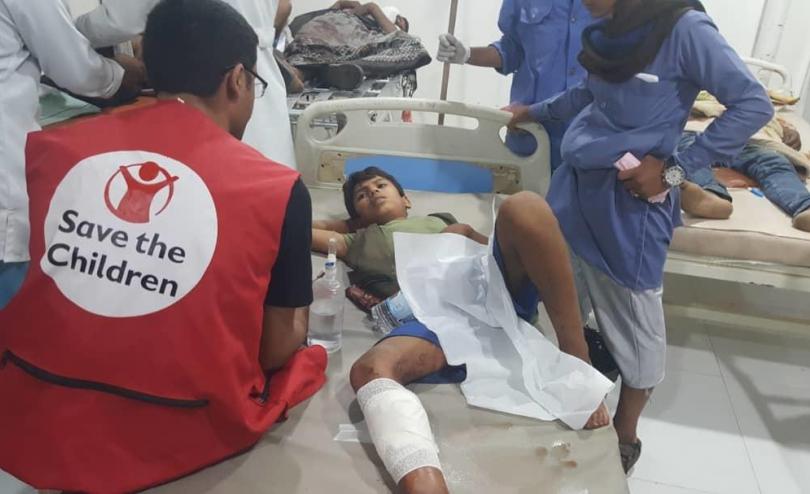Save the Children on UN report on children in armed conflict

With at least 1689 Yemeni children killed or maimed in 2018, children are still bearing the brunt of the conflict in Yemen, Save the Children warned today. Some 729 of the child casualties were a result of attacks by the Saudi and Emirati-led coalition, in addition to 15 attacks on schools and hospitals, according to the annual UN-report on Children and Armed Conflict.
Save the Children said UN Secretary-General Antonio Guterres has failed to fully hold the coalition to account by not including it on the annual ‘list of shame’ of the report for both these grave violations against children in Yemen.
Mohamad Al Asmar, Advocacy, Media & Communications Director for Save the Children in the Middle East, said:
“The UN has thoroughly documented appalling attacks against children in Yemen by all parties to the conflict, yet the Secretary-General failed to list the Saudi and Emirati-led coalition for all the grave violations it committed against children in Yemen in 2018. By doing so, he is effectively failing to hold the coalition to account for yet another year of bombing children in their homes and schools. This decision shows that the Secretary-General has placed politics before children and that states with powerful friends can get away with destroying children’s lives with impunity.”
The UN Secretary-General presented the Annual Report on Children and Armed Conflict today, documenting all grave violations against the rights of children living in conflict. These violations range from killing and maiming, recruitment and abduction to sexual abuse, the denial of access to humanitarian aid and attacks on schools and hospitals.
The report was launched one day after a busy market in northern Yemen was attacked, leaving 14 people dead, including 4 children - 11 other children are being treated for their wounds in a nearby hospital supported by Save the Children. Our staff reported seeing terrified children in pain, calling out for their parents. “I was in the market with my friends… It all happened so fast, I don’t know if they are dead or alive”, said the 12-year old Ali*. Four of his brothers are also being treated for their wounds.
Teams of the organization are supporting the affected children and their families by covering transportation costs and with psychosocial support. Save the Children strongly condemns the heinous attack, which shows that not enough is being done to keep Yemeni children safe.
In the annex of this years’ annual report, the Saudi and Emirati-led coalition is listed for the killing and maiming of children, but not for the attacks on schools and hospitals. Furthermore, it’s only listed in a ‘lighter’ section of the list, with parties that “have put in place measures aimed at improving the protection of children”. Yet the report clearly demonstrates that whatever these measures may be, they are not working, Save the Children said today.
The ‘list of shame’ at the end of the report contains 63 names of parties to conflicts around the world.
Al Asmar continued:
“Other perpetrators in the Yemen conflict are named on the list, as they should be. The decision not to name and shame the Saudi and Emirati-led coalition is not only a slap in the face for the Yemeni victims, it is also a huge blow to the UN’s credibility as a force for accountability. This should trigger loud public outrage calling for the Secretary-General to revisit his decision.
Some 420 million children worldwide are living in conflict-affected areas, facing the daily danger of being killed or maimed, sliding into famine or seeing their education halted because it’s too dangerous to go to school. This war on children needs to stop and one way of doing that is by holding perpetrators to account. Being listed by the UN is a way to do so, and this is truly a missed opportunity.”
The Saudi and Emirati-led Coalition is not the only actor that was named but not held fully accountable in the 2018 Annual Report, Save the Children emphasizes. Last year 927 children were killed and 2135 maimed in Afghanistan by all parties to the conflict, but not all were listed for it in the UN report. And despite a pattern of grave violations against children in the occupied Palestinian territories documented by the UN, the parties to the conflict were not listed in this year’s report.
The Secretary-General continues a worrying trend of shielding state armed or international forces from truly being held to account, Save the Children warns. The organization urges the Secretary-General to publish a complete list of perpetrators in this year’s and in future annual reports as an important step towards ensuring perpetrators stop committing grave violations against children. The listing decision should only be based on credible and UN-verified patterns of violations, not on political pressure. The implementation of a UN action plan to address and prevent grave violations against children must remain the formal and only path for removing a party from the list of shame.
*Name changed to protect privacy
NOTES TO EDITORS
- The SG’s Children and Armed Conflict report, which looks at violations against children committed in 2018, identified at least 24,000 verified grave violations around the world, in more than 20 country situations. It cites at least 11,484 cases of the killing and maiming of children, with the highest number of cases in Afghanistan, Syria and Yemen.
- On Yemen, the report found that killing and maiming of children remained the most prevalent violation, with 1689 child casualties – 576 killed and 1113 injured. Of these, 729 were attributable to the Saudi Arabia-led Coalition, and 398 to the Houthis.
- The annual report, which documents the grave violations against children in all major conflicts, contains a separate list (‘ANNEX’) of the actors responsible for the grave violations against children, also known as the list of shame.
- The list has been split since 2017, when a division was made between actors that gravely violate children’s rights, and actors that supposedly took measures to avoid making children casualties. This effectively offered a way out of the “list of shame” without any transparency on the criteria used to decide where a given party is placed.




